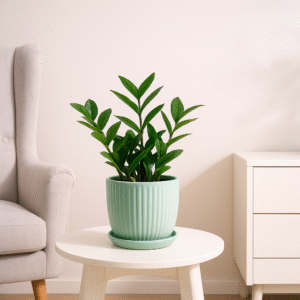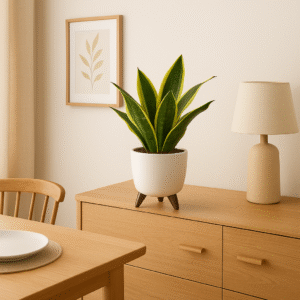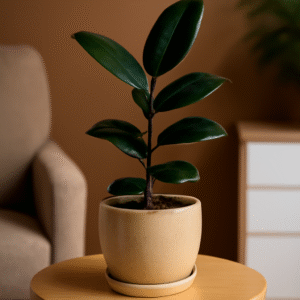Fresh herbs are a delight for every home. Whether you sprinkle coriander leaves over a curry, brew tulsi tea, or add mint to your lemonade, nothing compares to the flavor and health benefits of freshly plucked herbs from your own garden.
The good news? Growing herbs at home is surprisingly easy. With just a little sunlight, water, and care, you can cultivate a variety of herbs in your balcony, terrace, kitchen window, or even indoors.
This guide will walk you through step-by-step instructions on how to grow mint, coriander, tulsi (holy basil), and more popular Indian herbs that thrive in pots and containers.
Why Grow Herbs at Home?
- Freshness on Demand – No more wilted coriander from the fridge. You harvest when you cook.
- Health Benefits – Tulsi boosts immunity, mint aids digestion, and coriander helps detoxify.
- Cost-Effective – A one-time investment in seeds or saplings saves repeated grocery costs.
- Compact & Easy – Most herbs grow beautifully in small pots, making them perfect for apartments.
- Sustainable Living – Reduces your reliance on plastic-packed supermarket greens.
Essential Tips Before You Start
- Containers: Use pots with good drainage. Clay pots are excellent for herbs.
- Soil: Mix garden soil with compost and sand in equal parts for well-drained, fertile soil.
- Sunlight: Most herbs need 4–6 hours of sunlight daily.
- Watering: Herbs dislike overwatering. Keep soil moist but never soggy.
- Harvesting: Regular trimming encourages bushy growth and prevents plants from flowering too early.
How to Grow Mint (Pudina) at Home
Mint is one of the easiest herbs to grow. It spreads quickly and provides a refreshing aroma and flavor.
Growing Method:
- Use cuttings from existing mint stalks or buy saplings.
- Place the cutting in water until roots develop, then transfer to soil.
- Plant in a wide container since mint spreads horizontally.
Care Tips:
- Keep the soil moist but avoid waterlogging.
- Place in partial sunlight; too much heat can scorch the leaves.
- Regularly pinch off leaves to encourage new shoots.
Uses: Mint chutney, mojitos, teas, raita, and as a garnish.
How to Grow Coriander (Dhaniya) at Home
Coriander is a kitchen staple in every Indian household. The trick is to grow it fresh regularly.
Growing Method:
- Crush whole coriander seeds lightly and sow them in moist soil.
- Keep the soil damp until germination (7–10 days).
- Thin out seedlings once they sprout.
Care Tips:
- Coriander prefers cool weather (best in winter or shaded areas in summer).
- Requires 3–4 hours of sunlight.
- Harvest leaves regularly, but avoid plucking the entire plant at once.
Uses: Garnish for curries, chutneys, dals, and soups.
How to Grow Tulsi (Holy Basil) at Home
Tulsi is considered sacred in Indian homes and is valued for its medicinal and spiritual properties.
Growing Method:
- Sow tulsi seeds in a pot filled with moist soil.
- Keep the pot in a sunny spot, as tulsi thrives in warm conditions.
- Water lightly every 2–3 days.
Care Tips:
- Tulsi loves full sunlight (5–6 hours daily).
- Prune flowers regularly to keep the plant leafy.
- Protect from frost in colder regions.
Uses: Tulsi tea, immunity boosters, home remedies for cold and cough.
Other Easy-to-Grow Herbs for Indian Homes
Curry Leaves (Kadi Patta)
- Grows best in warm, sunny spots.
- Needs deep pots as it develops strong roots.
- Use fresh leaves for curries, rasam, and dals.
Fenugreek (Methi)
- Sow methi seeds directly in pots.
- Grows fast and can be harvested within 20–25 days.
- Great for parathas, curries, and salads.
Lemongrass
- Plant cuttings or stalks with roots attached.
- Thrives in sunny areas with regular watering.
- Perfect for teas, soups, and detox drinks.
Ajwain Leaves (Carom)
- Hardy, low-maintenance plant.
- Grows well in medium sunlight and minimal care.
- Useful for home remedies and flavoring dishes.
Common Mistakes to Avoid When Growing Herbs
- Overwatering: Roots rot quickly if soil is soggy.
- Poor Drainage: Always ensure pots have drainage holes.
- Neglecting Harvesting: If herbs flower, leaf production reduces. Trim often.
- Too Much Fertilizer: Herbs lose their flavor when over-fertilized. Use compost sparingly.
Where to Buy Fresh Herb Plants Online
You don’t always need to start herbs from seeds. Buying healthy, ready-to-grow plants saves time and ensures quick harvests.
At The Tarva, we offer a curated collection of herb plants that are perfect for Indian homes:
- Mint Plants – Fresh, aromatic, and fast-growing.
- Coriander Saplings – Ready to flourish in your kitchen garden.
- Tulsi Varieties – Rama, Krishna, and Lakshmi Tulsi plants.
- Other Herbs – Curry leaves, lemongrass, ajwain, and more.
Shop now at thetarva.com and get fresh herb plants delivered to your doorstep.
Conclusion
Growing herbs at home is one of the most rewarding gardening experiences. Not only do you get fresh flavors for your meals, but you also benefit from their immense health properties.
Start simple with mint, coriander, and tulsi, then expand into curry leaves, methi, and lemongrass. Within weeks, your kitchen garden will reward you with fresh, fragrant, and healthy greens — grown with your own hands.




